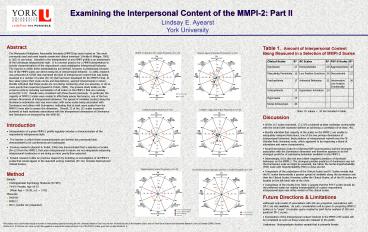Examining the Interpersonal Content of the MMPI2: Part II - PowerPoint PPT Presentation
1 / 1
Title:
Examining the Interpersonal Content of the MMPI2: Part II
Description:
... of variables (scales) along the dominance-submission axis was more even, with ... with the interpersonal dimensions of Dominance and Nurturance as measured by the ... – PowerPoint PPT presentation
Number of Views:110
Avg rating:3.0/5.0
Title: Examining the Interpersonal Content of the MMPI2: Part II
1
Examining the Interpersonal Content of the
MMPI-2 Part II
Lindsay E. Ayearst York University
- Abstract
- The Minnesota Multiphasic Personality Inventory
(MMPI) has been touted as the most commonly used
and most heavily researched clinical inventory
(Hicklin Widiger, 2000, p. 502) in use today.
Included in the interpretation of any MMPI
profile is an assessment of the individuals
interpersonal style. It is common practice for a
MMPI interpretation to include characterizations
of the respondents most maladaptive
interpersonal behavior. The manner in which
these interpretations are derived, however, is
problematic because few of the MMPI scales are
direct measures of interpersonal behavior. In
2006, research was presented at SITAR that
examined the kind of interpersonal content that
was being assessed in a number of scales (N13)
that had been developed for the MMPI-2 that, at
face value (given their scale names and
descriptions), seemed interpersonal in nature.
Results indicated that these scales are not
always measuring what one assumes, or do so more
poorly than expected (Ayearst Trobst, 2006).
The present study builds on this previous work by
including examination of all scales on the MMPI-2
that are routinely scored (N112). Results were
consistent with those found previously. In
particular, the majority of MMPI-2 scales were
unable to effectively assess Nurturance, one of
the two primary dimensions of interpersonal
behaviour. The spread of variables (scales) along
the dominance-submission axis was more even, with
some scales being associated with Dominance and
others with Submission, indicating that at least
some scales from the MMPI-2 were able to assess
this dimension. Overall, 23 of the 112 scales
examined achieved at least moderate associations
with the interpersonal dimensions of Dominance
and Nurturance as measured by the IASR-B5. - Introduction
- Interpretation of a given MMPI-2 profile
regularly includes a characterization of the
respondents interpersonal style. - The manner in which these characterizations are
derived has previously been demonstrated to be
cumbersome and inadequate. - Previous research (Ayearst Trobst, 2006) has
demonstrated that a selection of scales (N13)
from the MMPI-2 that seem interpersonal in nature
are not adequately measuring interpersonal
tendencies or are doing so more poorly than
expected. - Present research builds on previous research by
including an investigation of all MMPI-2 scales
that would appear in the standard scoring
materials (N112, includes Restructured Clinical
Scales). - Method
- Sample
- Undergraduate Psychology Students (N405)
- 74.6 Female Age 18-53
- (Mean Age 20.38, s.d. 3.93)
- Measures
- IASR-B5
- MMPI-2
- IIP-C (results not presented)
- Table 1. Amount of Interpersonal Content Being
Measured in a Selection of MMPI-2 Scales - Note R² values lt .10 not included in table.
- Discussion
- Of the 112 scales examined, 23 (21) achieved at
least moderate communality with the circle
(with moderate defined as achieving a correlation
of at least .40). - Results indicated that majority of the scales on
the MMPI-2 are unable to adequately measure
Nurturance, one of the two primary dimensions of
interpersonal behaviour. Best predictor of
interpersonal warmth was the GF (Gender-Role
feminine) scale, which appeared to be measuring a
blend of submissive and warm characteristics. - Social Introversion Scale Si1 (Shyness/Self-Consc
iousness) had the strongest association with the
Dominance dimension and therefore appears to be
the strongest predictor of submissive behaviour
available on the MMPI-2. - Interestingly, Si1 is also the best (albeit
negative) predictor of dominant behaviour on the
MMPI-2. The strongest positive predictor of
dominance was not the Dominance scale as might be
assumed, but rather the Social Imperturbability
(Pd3) scale with Imperturbability (Ma3) a close
second. - Comparison of the projections of the Clinical
Scales and RC Scales reveals that the RC scales
demonstrate a greater spread of variables along
the dominance axis than the Clinical Scales.
However, unlike the Clinical Scales, all of the
RC scales are located on the left hand side of
the circle. - Comparison of the results from Table 1 suggest
that the PSY-5 scales should be the preferred
scales for making interpretations of a given
respondents interpersonal style over either
version of the clinical scales. - Future Directions Limitations
- Although only results of associations with IAS
are presented, associations with IIP-C are also
available. As such, consideration will be given
to projecting MMPI-2 scales on to super
circumplex space created by joint factor analysis
of IAS and ipsatized IIP-C scores. - Examination of the interpersonal content
inherent in the MMPI-2-RF scales will be
completed as soon as these scales are released to
the public.
.
- .
- This project was in part funded through a number
of small granting agencies including the York
University Research Cost Fund, the York
University Faculty of Arts Research Grant, and
two Small Social Science and Humanities Research
Council of Canada (SSHRC) Grants. - Thanks to Dr. M. Gurtman who came up with the
suggestion to explore the content inherent in all
of the MMPI-2 scales, given that my data allowed
for it.































